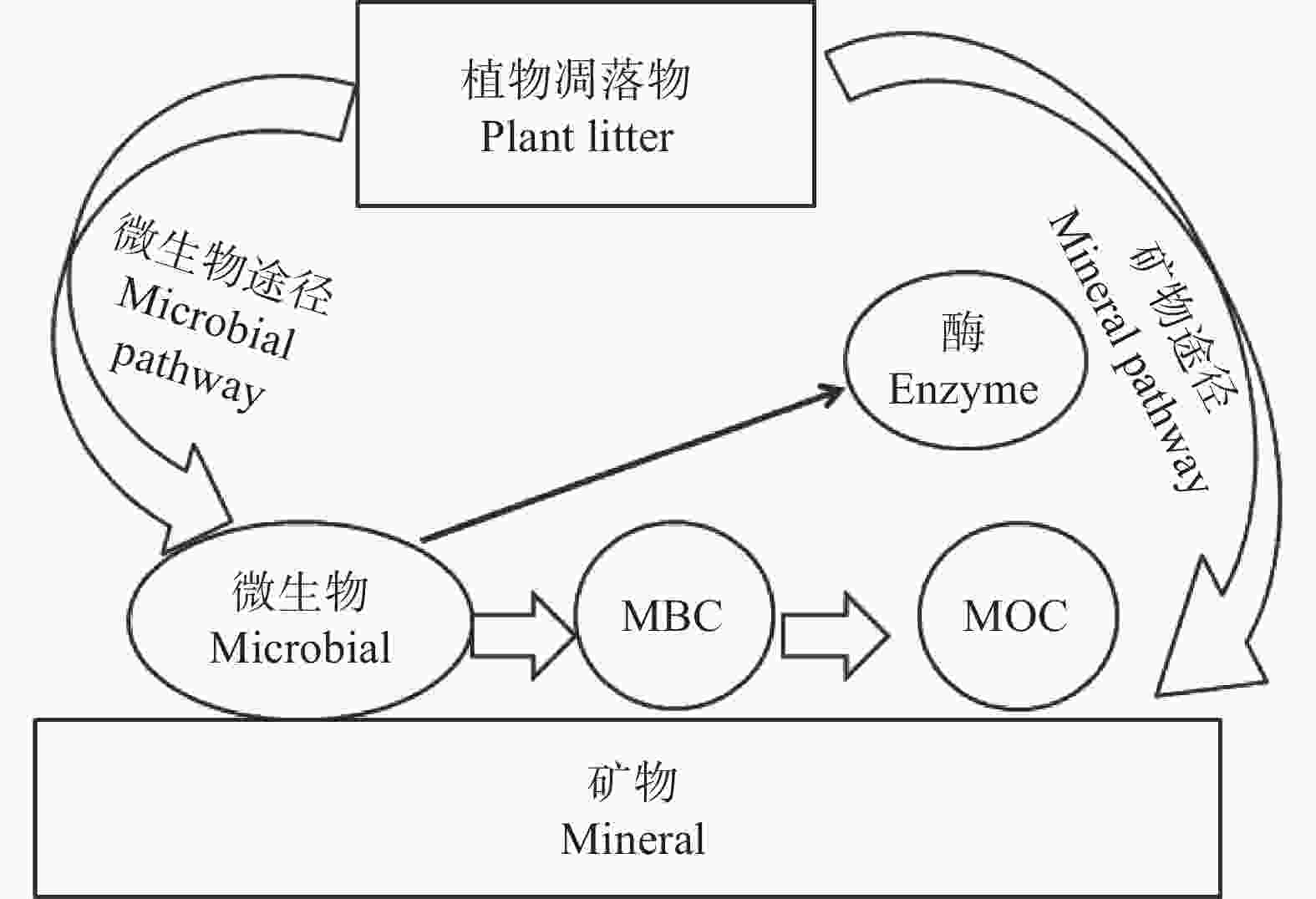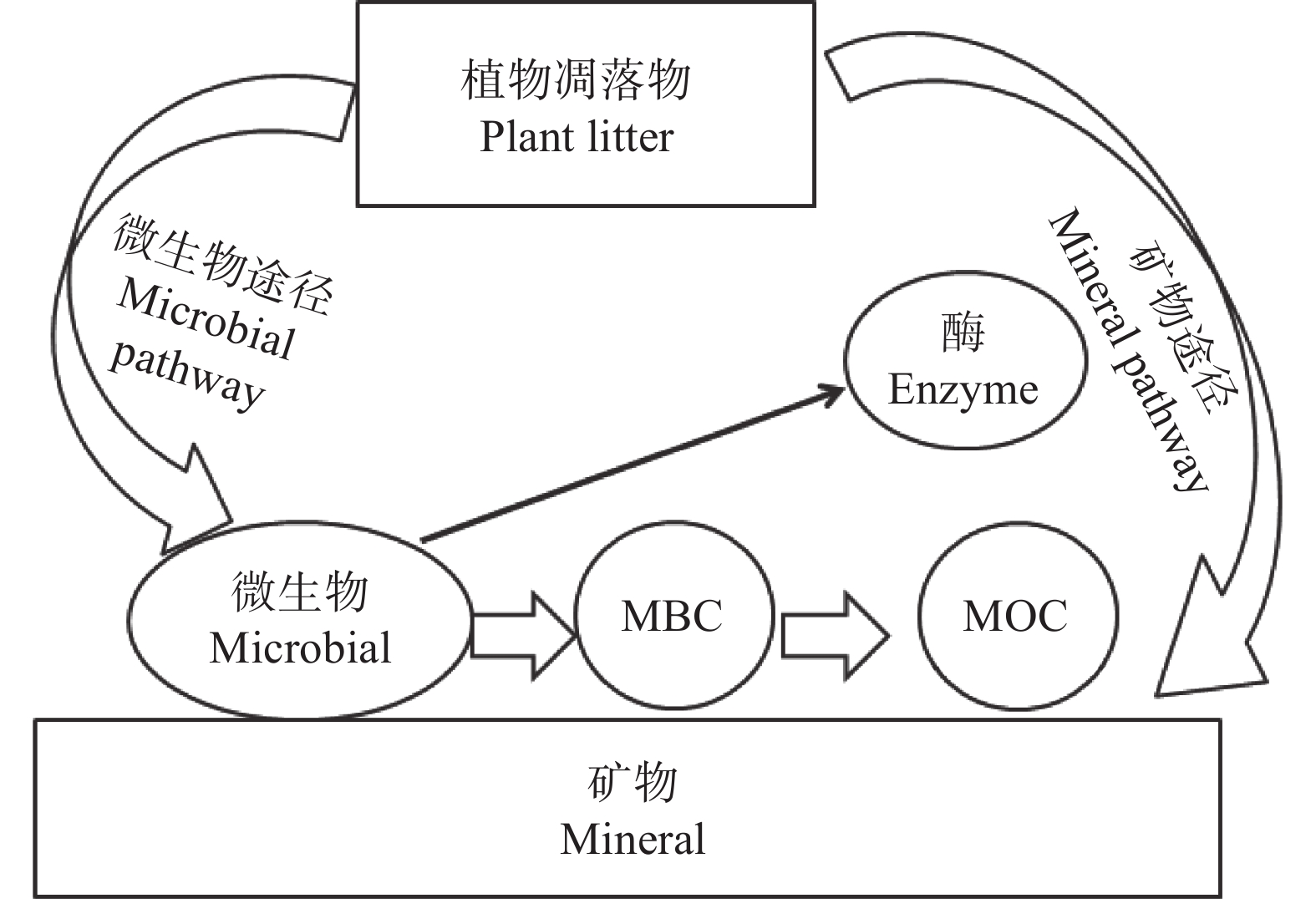| [1] |
CONANT R T, DRIJBER R A, HADDIX M L, et al. Sensitivity of organic matter decomposition to warming varies with its quality[J]. Global Change Biology, 2008, 14(4): 868−877 doi: 10.1111/j.1365-2486.2008.01541.x
|
| [2] |
LEHMANN J, KLEBER M. The contentious nature of soil organic matter[J]. Nature, 2015, 528(7580): 60−68 doi: 10.1038/nature16069
|
| [3] |
KRULL E S, BALDOCK J A, SKJEMSTAD J O. Importance of mechanisms and processes of the stabilisation of soil organic matter for modelling carbon turnover[J]. Functional Plant Biology: FPB, 2003, 30(2): 207−222 doi: 10.1071/FP02085
|
| [4] |
BLANCO-CANQUI H, LAL R. Mechanisms of carbon sequestration in soil aggregates[J]. Critical Reviews in Plant Sciences, 2004, 23(6): 481−504 doi: 10.1080/07352680490886842
|
| [5] |
RUMPEL C, KÖGEL-KNABNER I. Deep soil organic matter — A key but poorly understood component of terrestrial C cycle[J]. Plant and Soil, 2011, 338(1): 143−158
|
| [6] |
ANGST G, MUELLER K E, EISSENSTAT D M, et al. Soil organic carbon stability in forests: distinct effects of tree species identity and traits[J]. Global Change Biology, 2019, 25(4): 1529−1546 doi: 10.1111/gcb.14548
|
| [7] |
TORRES-SALLAN G, SCHULTE R P O, LANIGAN G J, et al. Clay illuviation provides a long-term sink for C sequestration in subsoils[J]. Scientific Reports, 2017, 7: 45635 doi: 10.1038/srep45635
|
| [8] |
DOETTERL S, STEVENS A, SIX J, et al. Soil carbon storage controlled by interactions between geochemistry and climate[J]. Nature Geoscience, 2015, 8(10): 780−783 doi: 10.1038/ngeo2516
|
| [9] |
KARHU K, HILASVUORI E, JÄRVENPÄÄ M, et al. Similar temperature sensitivity of soil mineral-associated organic carbon regardless of age[J]. Soil Biology and Biochemistry, 2019, 136: 107527 doi: 10.1016/j.soilbio.2019.107527
|
| [10] |
MIKUTTA R, MIKUTTA C, KALBITZ K, et al. Biodegradation of forest floor organic matter bound to minerals via different binding mechanisms[J]. Geochimica et Cosmochimica Acta, 2007, 71(10): 2569−2590 doi: 10.1016/j.gca.2007.03.002
|
| [11] |
GU B, SCHMITT J, CHEN Z, et al. Adsorption and desorption of natural organic matter on iron oxide: mechanisms and models[J]. Environmental Science & Technology, 1994, 28(1): 38−46
|
| [12] |
李学垣. 土壤化学[M]. 北京: 高等教育出版社, 2001LI X Y. Soil Chemistry[M]. Beijing: Higher Education Press, 2001
|
| [13] |
TOURNASSAT C, GRENECHE J M, TISSERAND D, et al. The titration of clay minerals:Ⅰ. Discontinuous backtitration technique combined with CEC measurements[J]. Journal of Colloid and Interface Science, 2004, 273(1): 224−233 doi: 10.1016/j.jcis.2003.11.021
|
| [14] |
ROWLEY M C, GRAND S, VERRECCHIA É P. Calcium-mediated stabilisation of soil organic carbon[J]. Biogeochemistry, 2018, 137(1): 27−49
|
| [15] |
KWON K D, VADILLO-RODRIGUEZ V, LOGAN B E, et al. Interactions of biopolymers with silica surfaces: Force measurements and electronic structure calculation studies[J]. Geochimica et Cosmochimica Acta, 2006, 70(15): 3803−3819 doi: 10.1016/j.gca.2006.05.016
|
| [16] |
PETRIDIS L, AMBAYE H, JAGADAMMA S, et al. Spatial arrangement of organic compounds on a model mineral surface: implications for soil organic matter stabilization[J]. Environmental Science & Technology, 2014, 48(1): 79−84
|
| [17] |
TOTSCHE K U, AMELUNG W, GERZABEK M H, et al. Microaggregates in soils[J]. Journal of Plant Nutrition and Soil Science, 2018, 181(1): 104−136 doi: 10.1002/jpln.201600451
|
| [18] |
DIAZ N, DIETRICH F, KING G E, et al. A 20-ka reconstruction of a Sahelo-Sudanian paleoenvironment using multi-method dating on pedogenic carbonate[C]//European Geosciences Union, EGU General Assembly 2016. Vienna, Austria, 2016: 42−43
|
| [19] |
ITO A, WAGAI R. Global distribution of clay-size minerals on land surface for biogeochemical and climatological studies[J]. Scientific Data, 2017, 4: 170103 doi: 10.1038/sdata.2017.103
|
| [20] |
WATTEL-KOEKKOEK E J W, BUURMAN P, VAN DER PLICHT J, et al. Mean residence time of soil organic matter associated with kaolinite and smectite[J]. European Journal of Soil Science, 2003, 54(2): 269−278 doi: 10.1046/j.1365-2389.2003.00512.x
|
| [21] |
WATTEL-KOEKKOEK E J W, BUURMAN P. Mean residence time of kaolinite and smectite-bound organic matter in Mozambiquan soils[J]. Soil Science Society of America Journal, 2004, 68(1): 154−161 doi: 10.2136/sssaj2004.1540
|
| [22] |
WATTEL-KOEKKOEK E J W, VAN GENUCHTEN P P L, BUURMAN P, et al. Amount and composition of clay-associated soil organic matter in a range of kaolinitic and smectitic soils[J]. Geoderma, 2001, 99(1/2): 27−49
|
| [23] |
SINGH M, SARKAR B, BISWAS B, et al. Relationship between soil clay mineralogy and carbon protection capacity as influenced by temperature and moisture[J]. Soil Biology and Biochemistry, 2017, 109: 95−106 doi: 10.1016/j.soilbio.2017.02.003
|
| [24] |
PARFITT R L. Allophane in New Zealand — A review[J]. Soil Research, 1990, 28(3): 343 doi: 10.1071/SR9900343
|
| [25] |
MARIA C. The role of aluminum-organo complexes in soil organic matter dynamics[M/OL]//HERNANDEZ-SORIANO M C. Soil Health and Land Use Management. InTech, 2012: 17−32. InTech, [2012-01-25]. http://www.intechopen.com/books/soil-health-and-land-usemanagement/the-role-of-aluminum-organo-complexes-in-soil-organic-matter-dynamics
|
| [26] |
RAKHSH F, GOLCHIN A, BEHESHTI AL AGHA A, et al. Mineralization of organic carbon and formation of microbial biomass in soil: effects of clay content and composition and the mechanisms involved[J]. Soil Biology and Biochemistry, 2020, 151: 108036 doi: 10.1016/j.soilbio.2020.108036
|
| [27] |
KAISER K, GUGGENBERGER G. The role of DOM sorption to mineral surfaces in the preservation of organic matter in soils[J]. Organic Geochemistry, 2000, 31(7/8): 711−725
|
| [28] |
GAO J, JANSEN B, CERLI C, et al. Organic matter coatings of soil minerals affect adsorptive interactions with phenolic and amino acids[J]. European Journal of Soil Science, 2018, 69(4): 613−624 doi: 10.1111/ejss.12562
|
| [29] |
LALONDE K, MUCCI A, OUELLET A, et al. Preservation of organic matter in sediments promoted by iron[J]. Nature, 2012, 483(7388): 198−200 doi: 10.1038/nature10855
|
| [30] |
KAISER K, GUGGENBERGER G. Mineral surfaces and soil organic matter[J]. European Journal of Soil Science, 2003, 54(2): 219−236 doi: 10.1046/j.1365-2389.2003.00544.x
|
| [31] |
PATZNER M S, MUELLER C W, MALUSOVA M, et al. Iron mineral dissolution releases iron and associated organic carbon during permafrost thaw[J]. Nature Communications, 2020, 11: 6329 doi: 10.1038/s41467-020-20102-6
|
| [32] |
MAYER L M. Relationships between mineral surfaces and organic carbon concentrations in soils and sediments[J]. Chemical Geology, 1994, 114(3/4): 347−363
|
| [33] |
WAGAI R, MAYER L M, KITAYAMA K. Extent and nature of organic coverage of soil mineral surfaces assessed by a gas sorption approach[J]. Geoderma, 2009, 149(1/2): 152−160
|
| [34] |
KIRSTEN M, MIKUTTA R, VOGEL C, et al. Iron oxides and aluminous clays selectively control soil carbon storage and stability in the humid tropics[J]. Scientific Reports, 2021, 11: 5076 doi: 10.1038/s41598-021-84777-7
|
| [35] |
HAN L F, SUN K, JIN J, et al. Some concepts of soil organic carbon characteristics and mineral interaction from a review of literature[J]. Soil Biology and Biochemistry, 2016, 94: 107−121 doi: 10.1016/j.soilbio.2015.11.023
|
| [36] |
KAISER K, GUGGENBERGER G. Sorptive stabilization of organic matter by microporous goethite: Sorption into small pores vs. surface complexation[J]. European Journal of Soil Science, 2007, 58(1): 45−59 doi: 10.1111/j.1365-2389.2006.00799.x
|
| [37] |
LEINEMANN T, PREUSSER S, MIKUTTA R, et al. Multiple exchange processes on mineral surfaces control the transport of dissolved organic matter through soil profiles[J]. Soil Biology and Biochemistry, 2018, 118: 79−90 doi: 10.1016/j.soilbio.2017.12.006
|
| [38] |
KÖGEL-KNABNER I, GUGGENBERGER G, KLEBER M, et al. Organo-mineral associations in temperate soils: Integrating biology, mineralogy, and organic matter chemistry[J]. Journal of Plant Nutrition and Soil Science, 2008, 171(1): 61−82 doi: 10.1002/jpln.200700048
|
| [39] |
AREVALO C B M, CHANG S X, BHATTI J S, et al. Mineralization potential and temperature sensitivity of soil organic carbon under different land uses in the parkland region of Alberta, Canada[J]. Soil Science Society of America Journal, 2012, 76(1): 241−251 doi: 10.2136/sssaj2011.0126
|
| [40] |
ANGST G, MUELLER K E, NIEROP K G J, et al. Plant-or microbial-derived? A review on the molecular composition of stabilized soil organic matter[J]. Soil Biology and Biochemistry, 2021, 156: 108189 doi: 10.1016/j.soilbio.2021.108189
|
| [41] |
KIEM R, KÖGEL-KNABNER I. Contribution of lignin and polysaccharides to the refractory carbon pool in C-depleted arable soils[J]. Soil Biology and Biochemistry, 2003, 35(1): 101−118 doi: 10.1016/S0038-0717(02)00242-0
|
| [42] |
JONES A R, SANDERMAN J, ALLEN D, et al. Subtropical giant podzol chronosequence reveals that soil carbon stabilisation is not governed by litter quality[J]. Biogeochemistry, 2015, 124(1): 205−217
|
| [43] |
SINGH B P, COWIE A L, SMERNIK R J. Biochar carbon stability in a clayey soil as a function of feedstock and pyrolysis temperature[J]. Environmental Science & Technology, 2012, 46(21): 11770−11778
|
| [44] |
KEITH A, SINGH B, SINGH B P. Interactive priming of biochar and labile organic matter mineralization in a smectite-rich soil[J]. Environmental Science & Technology, 2011, 45(22): 9611−9618
|
| [45] |
COLLINS H P, CHRISTENSON D R, BLEVINS R L, et al. Soil carbon dynamics in corn-based agroecosystems: results from carbon-13 natural abundance[J]. Soil Science Society of America Journal, 1999, 63(3): 584−591 doi: 10.2136/sssaj1999.03615995006300030022x
|
| [46] |
YE C L, BAI T S, YANG Y, et al. Physical access for residue-mineral interactions controls organic carbon retention in an Oxisol soil[J]. Scientific Reports, 2017, 7: 6317 doi: 10.1038/s41598-017-06654-6
|
| [47] |
COTRUFO M F, SOONG J L, HORTON A J, et al. Formation of soil organic matter via biochemical and physical pathways of litter mass loss[J]. Nature Geoscience, 2015, 8(10): 776−779 doi: 10.1038/ngeo2520
|
| [48] |
HADDIX M L, GREGORICH E G, HELGASON B L, et al. Climate, carbon content, and soil texture control the independent formation and persistence of particulate and mineral-associated organic matter in soil[J]. Geoderma, 2020, 363: 114160 doi: 10.1016/j.geoderma.2019.114160
|
| [49] |
KAISER K, GUGGENBERGER G, HAUMAIER L, et al. Dissolved organic matter sorption on sub soils and minerals studied by 13C-NMR and DRIFT spectroscopy[J]. European Journal of Soil Science, 1997, 48(2): 301−310 doi: 10.1111/j.1365-2389.1997.tb00550.x
|
| [50] |
DERRIEN D, MAROL C, BALABANE M, et al. The turnover of carbohydrate carbon in a cultivated soil estimated by 13C natural abundances[J]. European Journal of Soil Science, 2006, 57(4): 547−557 doi: 10.1111/j.1365-2389.2006.00811.x
|
| [51] |
KANG S, XING B S. Humic acid fractionation upon sequential adsorption onto Goethite[J]. Langmuir: the ACS Journal of Surfaces and Colloids, 2008, 24(6): 2525−2531 doi: 10.1021/la702914q
|
| [52] |
LEHMANN J, KINYANGI J, SOLOMON D. Organic matter stabilization in soil microaggregates: implications from spatial heterogeneity of organic carbon contents and carbon forms[J]. Biogeochemistry, 2007, 85(1): 45−57 doi: 10.1007/s10533-007-9105-3
|
| [53] |
AMELUNG W, FLACH K W, ZECH W. Neutral and acidic sugars in particle-size fractions as influenced by climate[J]. Soil Science Society of America Journal, 1999, 63(4): 865−873 doi: 10.2136/sssaj1999.634865x
|
| [54] |
SOLOMON D, LEHMANN J, ZECH W. Land use effects on soil organic matter properties of chromic luvisols in semi-arid northern Tanzania: carbon, nitrogen, lignin and carbohydrates[J]. Agriculture, Ecosystems & Environment, 2000, 78(3): 203−213
|
| [55] |
GUGGENBERGER G, CHRISTENSEN B T, ZECH W. Land-use effects on the composition of organic matter in particle-size separates of soil:Ⅰ. Lignin and carbohydrate signature[J]. European Journal of Soil Science, 1994, 45(4): 449−458 doi: 10.1111/j.1365-2389.1994.tb00530.x
|
| [56] |
NI X Y, LIAO S, TAN S Y, et al. A quantitative assessment of amino sugars in soil profiles[J]. Soil Biology and Biochemistry, 2020, 143: 107762 doi: 10.1016/j.soilbio.2020.107762
|
| [57] |
CÓRDOVA S C, OLK D C, DIETZEL R N, et al. Plant litter quality affects the accumulation rate, composition, and stability of mineral-associated soil organic matter[J]. Soil Biology and Biochemistry, 2018, 125: 115−124 doi: 10.1016/j.soilbio.2018.07.010
|
| [58] |
HUANG W J, HAMMEL K E, HAO J L, et al. Enrichment of lignin-derived carbon in mineral-associated soil organic matter[J]. Environmental Science & Technology, 2019, 53(13): 7522−7531
|
| [59] |
THEVENOT M, DIGNAC M F, RUMPEL C. Fate of lignins in soils: A review[J]. Soil Biology and Biochemistry, 2010, 42(8): 1200−1211 doi: 10.1016/j.soilbio.2010.03.017
|
| [60] |
KLOTZBÜCHER T, KALBITZ K, CERLI C, et al. Gone or just out of sight? The apparent disappearance of aromatic litter components in soils[J]. SOIL, 2016, 2(3): 325−335 doi: 10.5194/soil-2-325-2016
|
| [61] |
HERNES P J, KAISER K, DYDA R Y, et al. Molecular trickery in soil organic matter: hidden lignin[J]. Environmental Science & Technology, 2013, 47(16): 9077−9085
|
| [62] |
LIN L H, SIMPSON M J. Enhanced extractability of cutin-and suberin-derived organic matter with demineralization implies physical protection over chemical recalcitrance in soil[J]. Organic Geochemistry, 2016, 97: 111−121 doi: 10.1016/j.orggeochem.2016.04.012
|
| [63] |
GLASER B, BALASHOV E, HAUMAIER L, et al. Black carbon in density fractions of anthropogenic soils of the Brazilian Amazon region[J]. Organic Geochemistry, 2000, 31(7/8): 669−678
|
| [64] |
徐嘉晖, 孙颖, 高雷, 等. 土壤有机碳稳定性影响因素的研究进展[J]. 中国生态农业学报, 2018, 26(2): 222−230XU J H, SUN Y, GAO L, et al. A review of the factors influencing soil organic carbon stability[J]. Chinese Journal of Eco-Agriculture, 2018, 26(2): 222−230
|
| [65] |
COTRUFO M F, WALLENSTEIN M D, BOOT C M, et al. The Microbial Efficiency-Matrix Stabilization (MEMS) framework integrates plant litter decomposition with soil organic matter stabilization: do labile plant inputs form stable soil organic matter?[J]. Global Change Biology, 2013, 19(4): 988−995 doi: 10.1111/gcb.12113
|
| [66] |
KEILUWEIT M, BOUGOURE J J, NICO P S, et al. Mineral protection of soil carbon counteracted by root exudates[J]. Nature Climate Change, 2015, 5(6): 588−595 doi: 10.1038/nclimate2580
|
| [67] |
YANG J Q, ZHANG X N, BOURG I C, et al. 4D imaging reveals mechanisms of clay-carbon protection and release[J]. Nature Communications, 2021, 12: 622 doi: 10.1038/s41467-020-20798-6
|
| [68] |
WOOLF D, LEHMANN J. Microbial models with minimal mineral protection can explain long-term soil organic carbon persistence[J]. Scientific Reports, 2019, 9: 6522 doi: 10.1038/s41598-019-43026-8
|
| [69] |
MCFARLAND J W, WALDROP M P, STRAWN D G, et al. Biological and mineralogical controls over cycling of low molecular weight organic compounds along a soil chronosequence[J]. Soil Biology and Biochemistry, 2019, 133: 16−27 doi: 10.1016/j.soilbio.2019.01.013
|
| [70] |
KLEBER M, EUSTERHUES K, KEILUWEIT M, et al. Mineral-organic associations: formation, properties, and relevance in soil environments[J]. Advances in Agronomy, 2015, 130: 1−140
|
| [71] |
ROLLER B R K, SCHMIDT T M. The physiology and ecological implications of efficient growth[J]. The ISME Journal, 2015, 9(7): 1481−1487 doi: 10.1038/ismej.2014.235
|
| [72] |
SUSHKO M L, ROSSO K M. The origin of facet selectivity and alignment in anatase TiO2 nanoparticles in electrolyte solutions: implications for oriented attachment in metal oxides[J]. Nanoscale, 2016, 8(47): 19714−19725 doi: 10.1039/C6NR06953C
|
| [73] |
LIANG C, SCHIMEL J P, JASTROW J D. The importance of anabolism in microbial control over soil carbon storage[J]. Nature Microbiology, 2017, 2: 17105 doi: 10.1038/nmicrobiol.2017.105
|
| [74] |
LEHMANN J, HANSEL C M, KAISER C, et al. Persistence of soil organic carbon caused by functional complexity[J]. Nature Geoscience, 2020, 13(8): 529−534 doi: 10.1038/s41561-020-0612-3
|
| [75] |
SOKOL N W, SANDERMAN J, BRADFORD M A. Pathways of mineral-associated soil organic matter formation: Integrating the role of plant carbon source, chemistry, and point of entry[J]. Global Change Biology, 2019, 25(1): 12−24 doi: 10.1111/gcb.14482
|
| [76] |
SAMSON M E, CHANTIGNY M H, VANASSE A, et al. Management practices differently affect particulate and mineral-associated organic matter and their precursors in arable soils[J]. Soil Biology and Biochemistry, 2020, 148: 107867 doi: 10.1016/j.soilbio.2020.107867
|
| [77] |
MIKUTTA R, TURNER S, SCHIPPERS A, et al. Microbial and abiotic controls on mineral-associated organic matter in soil profiles along an ecosystem gradient[J]. Scientific Reports, 2019, 9: 10294 doi: 10.1038/s41598-019-46501-4
|
| [78] |
TIPPING E. Modelling Al competition for heavy metal binding by dissolved organic matter in soil and surface waters of acid and neutral pH[J]. Geoderma, 2005, 127(3/4): 293−304
|
| [79] |
MAYES M A, HEAL K R, BRANDT C C, et al. Relation between soil order and sorption of dissolved organic carbon in temperate subsoils[J]. Soil Science Society of America Journal, 2012, 76(3): 1027−1037 doi: 10.2136/sssaj2011.0340
|
| [80] |
AVERILL C, WARING B. Nitrogen limitation of decomposition and decay: How can it occur?[J]. Global Change Biology, 2018, 24(4): 1417−1427 doi: 10.1111/gcb.13980
|
| [81] |
WHITTINGHILL K A, HOBBIE S E. Effects of pH and calcium on soil organic matter dynamics in Alaskan tundra[J]. Biogeochemistry, 2012, 111(1): 569−581
|
| [82] |
COTRUFO M F, RANALLI M G, HADDIX M L, et al. Soil carbon storage informed by particulate and mineral-associated organic matter[J]. Nature Geoscience, 2019, 12(12): 989−994 doi: 10.1038/s41561-019-0484-6
|
| [83] |
MURPHY E M, ZACHARA J M, SMITH S C, et al. Interaction of hydrophobic organic compounds with mineral-bound humic substances[J]. Environmental Science & Technology, 1994, 28(7): 1291−1299
|
| [84] |
TONNEIJCK F H, JANSEN B, NIEROP K G J, et al. Towards understanding of carbon stocks and stabilization in volcanic ash soils in natural Andean ecosystems of northern Ecuador[J]. European Journal of Soil Science, 2010, 61(3): 392−405 doi: 10.1111/j.1365-2389.2010.01241.x
|
| [85] |
CRAIG M E, TURNER B L, LIANG C, et al. Tree mycorrhizal type predicts within-site variability in the storage and distribution of soil organic matter[J]. Global Change Biology, 2018, 24(8): 3317−3330 doi: 10.1111/gcb.14132
|
| [86] |
DING X L, QIAO Y F, FILLEY T, et al. Long-term changes in land use impact the accumulation of microbial residues in the particle-size fractions of a Mollisol[J]. Biology and Fertility of Soils, 2017, 53(3): 281−286 doi: 10.1007/s00374-017-1179-z
|
| [87] |
TURRIÓN M B, GLASER B, ZECH W. Effects of deforestation on contents and distribution of amino sugars within particle-size fractions of mountain soils[J]. Biology and Fertility of Soils, 2002, 35(1): 49−53 doi: 10.1007/s00374-001-0440-6
|
| [88] |
GLASER B, TURRIÓN M-B, SOLOMON D, et al. Soil organic matter quantity and quality in mountain soils of the Alay Range, Kyrgyzia, affected by land use change[J]. Biology and Fertility of Soils, 2000, 31(5): 407−413 doi: 10.1007/s003749900187
|
| [89] |
KLEBER M, BOURG I C, COWARD E K, et al. Dynamic interactions at the mineral-organic matter interface[J]. Nature Reviews Earth & Environment, 2021, 2(6): 402−421
|
| [90] |
SHI A D, CHAKRAWAL A, MANZONI S, et al. Substrate spatial heterogeneity reduces soil microbial activity[J]. Soil Biology and Biochemistry, 2021, 152: 108068 doi: 10.1016/j.soilbio.2020.108068
|






 下载:
下载:



